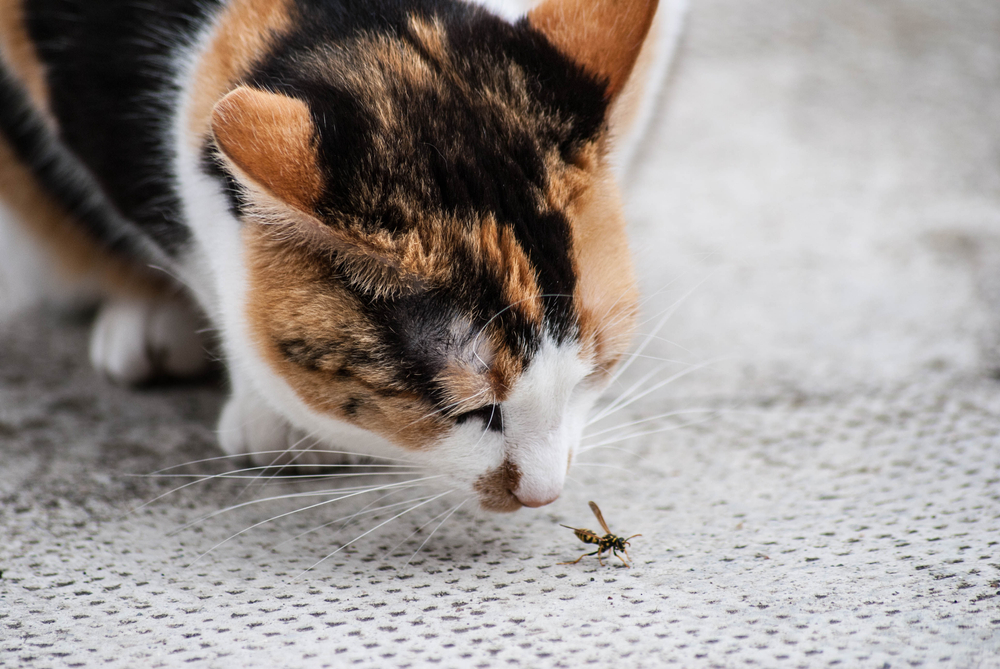Bugs tend to come out in force in the summer. Pets are often curious about these creepy crawlies. This is a bad combination that can lead to your pet being bitten or stung. Our Animal Hospital of Parkland team knows that bugs can be extremely irritating, and we provide information on five bugs that may bug your pet.
#1: Mosquitoes can bug your pet
Washington is home to more than 40 blood-thirsty mosquito species that don’t mind feeding on your furry pal. Mosquitoes bite and cause redness and itching, but their real danger is their ability to transmit heartworms. When they take a blood meal from an infected canid, they ingest baby heartworms. Then, they snack on your four-legged friend, and these tiny parasites can enter your pet, and eventually cause significant heart and lung damage. Therefore, year-round heartworm prevention medication is imperative to protect your pet from these dangerous parasites. In addition, dogs should be tested for heartworms at their annual wellness examination.
#2: Fleas can bug your pet
Fleas are the most common external parasite to bother pets. These blood-sucking parasites can ingest up to 15 times their body weight in blood and cause serious complications for your furry pal. Their insatiable appetite can lead to anemia, especially in small pets, and they can also transmit diseases and parasites. The most common flea issue is flea allergy dermatitis (FAD), which affects pets who are allergic to the flea’s saliva, and can cause excessive itchiness and potentially a secondary skin infection after only a single bite. Skin lesions and hair loss typically occur on the lower back, inner thighs, and belly. Treatment involves:
- Flea removal — Bathing can help remove fleas and their excrement, known as flea dirt.
- Environmental management — Fleas must be eradicated from the pet’s environment. This is a lengthy process that involves sweeping and vacuuming the floors and upholstery, washing bedding, and treating surfaces with an appropriate insecticide. Fleas have a complicated life cycle, and these steps must be repeated several times until all fleas at every life cycle are eliminated.
- Flea prevention — Your pet should receive a veterinary-approved flea prevention medication year-round.
#3: Ticks can bug your pet
Ticks commonly target pets and their bite can become infected, but the main concern about finding a tick on your pet is the potential for disease transmission. Ticks can transmit diseases, such as Lyme, Rocky Mountain spotted fever, anaplasmosis, tick relapsing fever, and tick paralysis, that can be debilitating and potentially lead to organ damage and neurological complications. Signs may include lethargy, swollen lymph nodes, fever, joint pain, shifting limb lameness, and an inability to use the hindlimbs. Tips to protect your pet from these dangerous parasites include:
- Providing tick prevention — Your pet should receive a veterinary-approved tick prevention medication year-round. These products don’t stop a tick from biting your pet, but they prevent the tick from completing its blood meal and transmitting disease.
- Checking your pet — Check your pet for ticks daily, especially after outings. Ticks can attach anywhere on your pet, but common sites include in their ears, on their face, between their toes, in the groin area, and under their tail and collar.
- Removing the tick — Remove ticks that you find on your pet as soon as possible, since most ticks need at least 24 hours to transmit disease. Tips for proper removal include:
-
- Grasp the tick using blunt-tipped tweezers or a tick removal tool.
- Pull upward firmly, avoiding twisting or crushing the tick.
- Place the tick in alcohol, so you can identify the species.
- Clean the bite site and then wash your hands thoroughly.
- Monitor the bite site for redness, swelling, and discharge, and monitor your pet for indications of a tick-borne illness.
#4: Black flies can bug your pet
Black flies, also called buffalo gnats, are tiny biting flies that are especially active in the summer. Their bites can be irritating, but they don’t spread disease. The bites, which appear as a nickle-sized, bright red circle with a dot in the middle, can occur anywhere on your pet’s body, but typically appear on the stomach or inner thighs. Black fly bites typically resolve without treatment, but an oatmeal bath or a cold pack can help alleviate your pet’s discomfort. Avoid using calamine lotion, since zinc oxide is toxic to pets.
#5: Bees can bug your pet

Many pets love to chase flying insects and end up with a bee sting, most commonly in the mouth or on the face. Your pet likely will lick or paw at the area, which you should check to see if the bee left the stinger behind. If so, remove the stinger to prevent continued venom administration. Some pets are allergic to stinging insects and need immediate veterinary care. Allergy signs include:
- Swelling — Swelling that affects your pet’s face or throat can inhibit their ability to breathe.
- Hives — If your pet develops hives after a bee sting, they may develop anaphylaxis.
- Gastrointestinal upset — If your pet is vomiting or has diarrhea after an insect sting, seek immediate veterinary care.
- Neurological abnormalities — Abnormalities such as dizziness, disorientation, weakness, or seizures following an insect sting indicate anaphylaxis.
If your pet needs veterinary care after being bugged by a bug, contact our Animal Hospital of Parkland, so we can determine the best treatment strategy.

